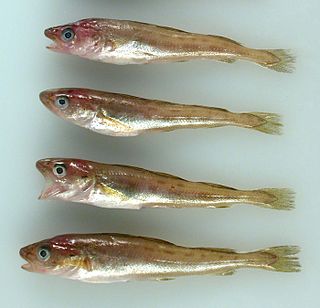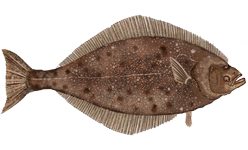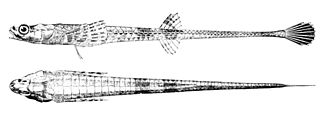
The walrus is a large flippered marine mammal with a discontinuous distribution about the North Pole in the Arctic Ocean and subarctic seas of the Northern Hemisphere. The walrus is the only living species in the family Odobenidae and genus Odobenus. This species is subdivided into two subspecies: the Atlantic walrus, which lives in the Atlantic Ocean, and the Pacific walrus, which lives in the Pacific Ocean.

Cod is the common name for the demersal fish genus Gadus, belonging to the family Gadidae. Cod is also used as part of the common name for a number of other fish species, and one species that belongs to genus Gadus is commonly not called cod.

The Atlantic cod is a benthopelagic fish of the family Gadidae, widely consumed by humans. It is also commercially known as cod or codling. Dry cod may be prepared as unsalted stockfish, and as cured salt cod or clipfish.

Halibut is the common name for three flatfish in the genera Hippoglossus and Reinhardtius from the family of right-eye flounders and, in some regions, and less commonly, other species of large flatfish.

An ocean current is a continuous, directed movement of sea water generated by a number of forces acting upon the water, including wind, the Coriolis effect, breaking waves, cabbeling, and temperature and salinity differences. Depth contours, shoreline configurations, and interactions with other currents influence a current's direction and strength. Ocean currents are primarily horizontal water movements.

Boreogadus saida, known as the polar cod or as the Arctic cod, is a fish of the cod family Gadidae, related to the true cod. Another fish species for which both the common names Arctic cod and polar cod are used is Arctogadus glacialis.

The Pacific cod is a species of ray-finned fish in the family Gadidae. It is a bottom-dwelling fish found in the northern Pacific Ocean, mainly on the continental shelf and upper slopes, to depths of about 900 m (3,000 ft). It can grow to a length of a meter or so and is found in large schools. It is an important commercial food species and is also known as gray cod or grey cod, and grayfish or greyfish. Fishing for this species is regulated with quotas being allotted for hook and line fishing, pots, and bottom trawls.

Gadus is a genus of demersal fish in the family Gadidae, commonly known as cod, although there are additional cod species in other genera. The best known member of the genus is the Atlantic cod.

Arctogadus glacialis, known also with ambiguous common names Arctic cod and polar cod, is an Arctic species of fish in the cod family Gadidae, related to the true cod. Arctogadus glacialis is found in icy water. They grow to about 30 cm long, and are favorite food of narwhals and other arctic whales.

The saffron cod(Eleginus gracilis) is a commercially harvested fish closely related to true cods. It is dark grey-green to brown, with spots on its sides and pale towards the belly. It may grow to 55 cm and weigh up to 1.3 kg.

Hippoglossus stenolepis, the Pacific halibut, is a species of righteye flounder. This very large species of flatfish is native to the North Pacific and is fished by commercial fisheries, sport fishers, and subsistence fishers.

The Pacific ocean perch, also known as the Pacific rockfish, Rose fish, Red bream or Red perch, is a fish whose range spans across the North Pacific : from southern California around the Pacific rim to northern Honshū, Japan, including the Bering Sea. The species appears to be most abundant in northern British Columbia, the Gulf of Alaska, and the Aleutian Islands.
Rossia moelleri is a species of bobtail squid native to the northern Atlantic Ocean and the Arctic Ocean, eastward to the Laptev Sea and westward to Amundsen Bay. It occurs off western and northeastern Greenland, northeastern Canada, Labrador, Spitsbergen, Jan Mayen, and in the Kara Sea. R. moelleri lives at depths from 17 to 250 m.

The Alaska pollock or walleye pollock is a marine fish species of the cod genus Gadus and family Gadidae.

In 1992, Northern Cod populations fell to 1% of historical levels, due in large part to decades of overfishing. The Canadian Federal Minister of Fisheries and Oceans, John Crosbie, declared a moratorium on the Northern Cod fishery, which for the preceding 500 years had primarily shaped the lives and communities of Canada's eastern coast. A significant factor contributing to the depletion of the cod stocks off Newfoundland's shores was the introduction of equipment and technology that increased landed fish volume. From the 1950s onwards, new technology allowed fishers to trawl a larger area, fish more in-depth, and for a longer time. By the 1960s, powerful trawlers equipped with radar, electronic navigation systems, and sonar allowed crews to pursue fish with unparalleled success, and Canadian catches peaked in the late-1970s and early-1980s. Cod stocks were depleted at a faster rate than could be replenished.

Cod fisheries are fisheries for cod. Cod is the common name for fish of the genus Gadus, belonging to the family Gadidae, and this article is confined to three species that belong to this genus: the Atlantic cod, the Pacific cod and the Greenland cod. Although there is a fourth species of the cod genus Gadus, Alaska pollock, it is commonly not called cod and therefore currently not covered here.

Aega psora is a species of isopod crustacean that parasitises a number of fish species in the North Atlantic. It is a serious ectoparasite of larger species of fish, particularly when they are injured.

The Alligatorfish is a fish in the family Agonidae (poachers). It was described by Marcus Elieser Bloch in 1786. It is a marine, temperate water-dwelling fish which is known from the northwestern Atlantic Ocean, including western Greenland; Labrador, Canada; and Cape Cod, Massachusetts, USA. It dwells at a depth range of 0–695 metres, most often around 60–150 m, and inhabits sand and mud bottoms mostly on the lower continental shelf all year. It prefers a temperature range of -1.07 to 2.52 °C. Males can reach a maximum total length of 22 centimetres, but more commonly reach a TL of 14.2 cm.
The gray starsnout is a fish in the family Agonidae (poachers). It was described by Charles Henry Gilbert in 1896. It is a marine, temperate water-dwelling fish which is known from the eastern Pacific Ocean, from the coast of the Bering Sea in Alaska, to the Oregon-California border. It dwells at a depth range of 18–252 metres, and inhabits rocky areas. Males can reach a maximum total length of 13 centimetres.
The bigeye poacher is a fish in the family Agonidae (poachers). It was described by Charles Henry Gilbert in 1890. It is a marine, subtropical fish which is known from the Gulf of Alaska to southern California, USA, in the northern Pacific Ocean. It dwells at a depth range of 110–910 metres, and inhabits soft bottoms. Males can reach a maximum total length of 23 centimetres.


















